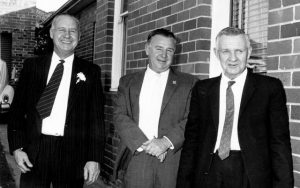Running a bit behind but finally getting my Week 7 post up.
For this week’s prompt, I scoured my family tree looking for someone who was married on Valentine’s Day or was called Valentine but there was no one. I also don’t really have any Valentine’s Day stories, so I thought outside the box and decided to write about someone called Rose as roses are typically given on Valentine’s Day.
Let me introduce you to Rose Beatrice NIPPERESS. Rose was the first wife of my great grand uncle (my great grandmother’s brother). I don’t really know a lot about this lady, perhaps because she isn’t really and ancestor more a family connection, but when researching her husband William Edward (Eddie) THOMPSON I found that she went through some hard times. Rose had been born in 1910 in the Lismore, NSW area and grew up there as did Eddie. The couple married in 1937 in Lismore and by 1941 the young couple had a lovely baby girl. But everything went south when Eddie enlisted into the Australian army in 1942 and was posted overseas to Papua New Guinea. I can just imagine Rose sending her husband off to war, thinking that perhaps she might never see him again but that he was ‘doing his bit’ for the war effort. Little did Rose know that the war would change their little family forever.
Prior to being posted overseas, Eddie conducted training exercises in the northern areas of Australia and according to his war records he was granted special leave without pay 30 April 1942. Presumably, he went home to see his family

Rose and Eddie THOMPSON with their daughter
before being shipped out overseas. Photos of the young family lend credibility to this argument, with Eddie appearing in his army uniform in the photos. However, it seems Eddie never actually made it overseas. A pattern of being AWOL
emerges in his records, the first occurrence happening 2 October 1942 and lasting till 3 November 1942. His pay was docked and he was placed in detention. But he didn’t learn his lesson and absented himself again following more training and this time he never returned to the army. A warrant was issued for his arrest but he was never found and he was discharged for misconduct in 1946.
As Eddie’s next of kin, I presume that Rose would have been informed about her husbands desertion or at the very least questioned about his whereabouts. But she presumably didn’t know about his whereabouts at that time or for some time after. Interestingly, Eddie’s war records include letters from family members to army officials looking for his whereabouts but none from his wife. Who knows what the reason for this is: embarrassment and shame that her husband had not only deserted from the army, but hadn’t seen fit to return to his wife and child or perhaps she was simply struggling to keep her and her daughter afloat.
Nobody I have spoken to in the family knows if Rose was ever contacted by Eddie again but one way or another a divorce must have occurred as in 1952 Rose remarried. She and her new husband continued to live in the Lismore area where Rose and Eddie’s daughter was also presumably raised.




